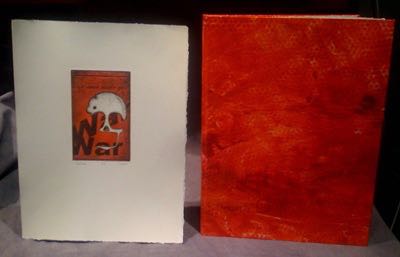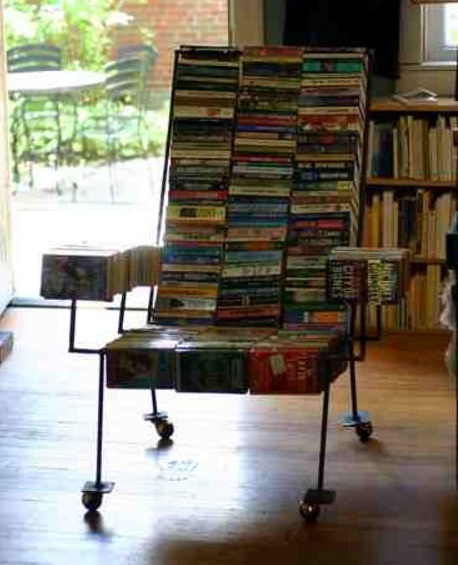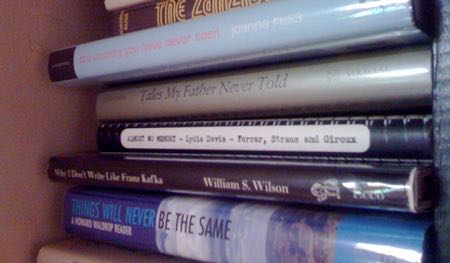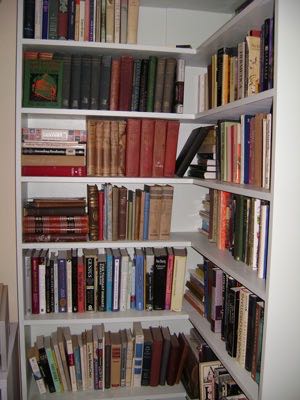
February to November 2008

4 November 08
“. . . it changes everything. It changes the world.”
At the end of September, the Anonymous Other invited me to the New York
Public Library to hear Spike Lee and James McBride speak .
When the conversation turned to politics, Lee refused the moderator’s
conditional sentence again and again, and said, “ When Barack
Obama is elected, people can expect miracles. He’s going to inherit,
he’s going to have the worst mess on his hands of any president in
a long, long time . . . To me, it changes everything. It
changes the world. . . . Even with their shenanigans, they
won’t be able to steal this one. ”
Time to start working on the changes.
31 October 08
A new book from Temporary Culture :
Forever Peace. To Stop War
Poem by Joe Haldeman
Nine Etchings by Judith Clute
11 x 14 inches, [4] pp. + 9 original etchings (each signed by the artist)Edition of 25 copies signed by the author and artist, with aquatint etchings printed by the artist from the original plates (two with added color, each plate signed and numbered by the artist), text printed letterpress by David Wolfe, hand bound in pastepaper over boards by Henry Wessells. Published today, 31 October 2008, in Upper Montclair and London.
Most of the edition is spoken for, but a few copies are available. Terms of subscription and further details .
Additional pictures of the bindery process will be posted soon.
27 October 08
— Captain
Gault. Being the Exceedingly Private Log of a Sea-Captain by
William Hope Hodgson (Eveleigh Nash, 1917). Collection of short stories
narrated in an arch, post-Edwardian manner by Captain Gault, ladiesÍ man,
scrupulous patriot, and unscrupulous, undetected smuggler of jewels and
military goods.
— Radio Free Albemuth by Philip K. Dick (1985; Avon
paperback, 1987) [RR]. Precursor to Valis (1981) but published
posthumously, the novel essentially describes the plot of the movie that Horselover
Fat and Phil and Kevin go see in Valis . A seriously paranoid vision
of America under the totalitarian rule of Ferris Fremont, a Nixon analogue, and
a novel that has uncanny relevance to the erosion of liberty in recent years.
“Denouncing an organization that doesn’t even exist — one Fremont made up and says it’s taking over America. Obviously no one can destroy it. No one’s safe from it. No one knows where it will turn up next.”
25-26 October 08
The Same Book : Reflections on Russell Hoban
Maybe loss is the main action of the universe and we’re here because the universe wants us to experience it. — Russell Hoban, Linger Awhile
There
are writers who write the same book again and again, and make their
fortunes in series characters who undergo many adventures without
the faintest echo of a hint of experience or change (let’s
avoid the implication of “development” ). The authors
may go mad, or farm out the work, or write a “non-series” novel
in the hope of . . . starting a different series.
I have less tolerance with fantasy or science fiction series now — so
I do not keep up with the interminable and less than fascinating
waves of vampire novels (for example) — but as an
earlier reader I made my way through the entire Doc Savage series
(still up there in the attic); ERB, REH, too; and I have read miles
of mystery novels and, once upon a time, the complete shelves of
Wodehouse and Rex Stout (there is a reason I cite those two authors
in the same sentence of my credentials : the play of language
and variation upon standard form). In the mystery sort of book, pick
your city, your language, your mode (hard-boiled, cozy, etc.), and
you can find a series. How many in any given series you will wish
to read is another matter altogether.
There are a few writers who tried to subvert the expectations of their
public (Janwillem van de Wetering, say, or X — you supply
the name of this candidate). John D. MacDonald tried but Travis McGee
was too rugged, too resourceful. L. A. Morse (a pseudonym, likely)
and Timothy Harris (see below) simply stopped after two novels.
And then there is Russell Hoban, who has written the same story — almost
the oldest story there is — four times (maybe more ?)
and yet each one is new for the reader — sometimes astonishingly
so — and I must presume, new and interesting for the
writer. Matt Madden, 99 Ways to tell a story. Exercises in style ,
did a visual adaptation of Raymond Queneau’s formal exercises (re-working
a fixed group of elements in different ways, some successful and intriguing,
others less so) but Hoban gets past the emphasis on dexterity of form
to accomplish something profound. His prose is brilliant.
— Her Name Was Lola (2003; Arcade Publishing, 2004)
— Come Dance with Me (Bloomsbury, 2005)
— Linger Awhile (2006; Godine, 2007)
Like The Medusa Frequency (1987) — an interpretation
of the Orpheus myth, as I recall — each of these three
novels features an articulate, flawed older protagonist who finds love
and then loses it, usually to comic effect but also to a succession of
more or less serious reflections on time and love and being human. Hoban
moves effortlessly from modern art to H. P. L. to classical
music and is always a pleasure to read. Something truly startling occurs
in the final pages of Come Dance with Me . I suspect there
are other novels where he plays with these conceits, and shall look for
the most recent, My Tango With Barbara Strozzi (2008).
Hoban is also author of The Mouse and His Child (1967)
and Riddley Walker (1980). Accordingly, The Encyclopedia
of Fantasy has something relevant :
Though often hilarious, RH is not a writer of comedy. His importance for the genre, beyond the visible merits of his large oeuvre, lies in his presentation of the anguished complexities attending his heroes’ attempts to penetrate the unsurpassable thresholds that mark our mortality.
recent
reading :
— Kyd for Hire by [Timothy] Hyde Harris (Gollancz,
1977). This is a candidate for that short list of perpetual favorites of the
Endless Bookshelf, a private eye novel in the same league as the best of Raymond
Chandler, where every word counts and where the city of Los Angeles is endowed
with a charm that is at once jaded and magical. Harris’ second private
eye novel, Good Night and Good-Bye (Delacort Press, 1979), is
equally compelling and an hommage to Chandler’s The
Long Good-bye that surpasses it. I learned recently that Harris wrote
a third Thomas Kyd novel after a very long interval, Unfaithful Servant (2004)
and I am curious to read it.
— The Brass Verdict by Michael Connelly (Little, Brown,
2008). Deft plotting, sure narrative voice, and some memorably despicable characters.
Connelly effects a collision of his character lines here, giving an account of
Harry Bosch in the first person voice of Mickey Haller, a defense lawyer haunted
by a number of private ghosts. There is a revelation that reads true and is fully
earned ; Connelly had planted the seeds for it long ago.
During the month from mid-August to early September, in addition to the
usual crop of unreadable vampire novels, I received dozens of review
copies of mystery novels, each more carefully calculated than the next
to create a niche : knitting, chocolate, wine, and so on ;
none retained my interest. I persevered with three others (joined by
a common thread), with mixed rewards.
— Blood Memory by Margaret Coel (Berkeley Prime Crime,
2008). Novel set in Denver, the interplay of tribes (Cheyenne and “old” Denver
money) and Indian casinos. The sections from the point of view of the hired assassin
lacked the sparkle of Jon A. Jackson’s crime narratives, but even when
the protagonist, a young journalist in search of her Indian heritage, makes some
ill-advised decisions she retains her agency and competency. The last Denver
mysteries I had read were those by Rex Burns a couple decades ago.
— Conspiracy of Silence by Martha Powers (Oceanview
Publishing, 2008). Confusion of genre signals : The first seventy pages
or so appeared to be a slow-paced, cozy mystery — a young journalist
in search of her true history — rife with pointless, excruciating
quotidian detail, occasional lurches in point of view, and belabored coincidence.
Dickens, on the other hand, simply pushed his coincidences into the plot and
let them dance away with the plot line. Just as events appeared to engage, the
protagonist fainted and the conventions of romance took over. However I think
there is a story behind the veils here, so I will probably continue. [N. B.
(later) : I did not.]
— Heartless by Alison Gaylin (Obsidian Mystery, 2008).
The protagonist, a young journalist haunted by private ghosts, makes some colossal
errors of judgment but manages to escape the clutches of the murderous cult she
stumbles upon during a visit to an idyllic expatriate enclave in Mexico. There
were a number of stylistic obstacles and twice I almost abandoned the novel.
27 September 08
Recent
reading :
— Death and the Gilded Man by Carter Dickson [John
Dickson Carr] (Pocket Books, [1947]). During the past month I read or re-read
a small sampling of the H. M. novels by John Dickson Carr, including My
Late Wives , The Peacock Feather Murders , and a posthumous
compendium of stories, Merrivale, March and Murder . John Dickson
Carr. The Man Who Explained Miracles by Douglas G. Greene (1995) is an interesting
and thorough biographical and critical study. A friend described the pleasures
of Carr : “ hours of locked rooms, bodies on the floor, dim-witted
debutantes, stalwart chaps, and of course, Sir Henry Merrivale and Dr. Gideon
Fell ”. I suppose my favorite of all the books by this prince of the
Golden Age detective writers is The Burning Court (1937), set
in an imaginary town on the Main Line. I shall look forward to re-reading it.
— Hugger-Mugger in the Louvre. A Homer Evans Murder Mystery by
Elliot Paul (Random House, second printing, [1940]). A nostalgic recreation even
when it was first issued : Paris in the 1920s with caricatures of American
expatriates and the form of the classic detective novel.

27 August 08
Heidegger and Coltrane

current reading
— Heidegger’s Hut by Adam Sharr (MIT Press, 2006).
Just handed to me by [PD] in response to a query about walking in the woods and
Heidegger.
— Traveling with Water Colors. A Guide to Creating Watercolor
Snapshots by Leon Loughridge (Denver : Dry
Creek Art Press, 2007).
— The Coroner’s Lunch by Colin Cotterill (Soho :
[2004], paperback). Complexity of plot and very effective use of the supernatural
and irrational, with a well drawn, exotic setting : Laos in the aftermath
of the Vietnam war.
— The Tragedy of The Duchess of Malfi by John Webster,
edited by Louis B. Wright and Virginia A. LaMar, from the text of the 1623 quarto
(Folger Library General Reader’s Edition, Washington Square paperback [1959]).
Intrigue and deception, Ferdinand, Duke of Calabria, and the brother of the Duchess
hire Daniel de Bosola, a mole who turns murderer. Pages very browned but the
drama is compelling. One memorable passage :
there o’erflows such melancholy humour they imagine themselves to be transformed into wolves, steal forth to churchyards in the dead of night and dig dead bodies up — as two nights since one met the Duke ’bout midnight in a lane behind Saint Mark’s church, with the leg of a man upon his shoulder; and he howl’d fearfully ; said he was a wolf, only the difference was, a wolf’s skin was hairy on the outside, his on the inside ; bade them take their swords, rip up his flesh, and try (Act V, scene II).
— After
London and Amaryllis at the Fair by Richard Jefferies.
Edited with an introduction by David Garnett (J.M. Dent, Everyman’s
Library, 1939). Filling a gap in my reading : After London (1885)
is one of the ancestral tales of the post-disaster genre, and Jefferies
is at his most lyrical in describing the flora and fauna of wild
England. This edition includes an introduction by David Garnett,
written under the shadow of war and with a poem by Julian Bell,
that is infinitely to be preferred over the commentary in the 1937
Faber & Faber anthology of Jeffries edited by Henry Williamson, Richard
Jefferies. Selections from His Work, with details of His Life and
Circumstance, His Death and Immortality (at p. 222 or
so — I don’t have that book handy but bristle
at thinking of the passage — Williamson makes an assertion
so appalling and utterly odious it seems almost impossible that
he and Garnett inhabited the same planet ; it is instructive
to remember that there were writers awake in Britain at that time :
Kay Burdekin wrote Swastika Night, which Gollancz published
in 1937 under the pseudonym Murray Constantine).
The Invisible Bookshelf
Compendium of imaginary books with their sources : here.
(Thanks to John Crowley.) I have suggested a few imaginary titles from
real books published by Temporary Culture.
21
August 08
Stop War
4973 : Berkeley Protest Posters 1970 [With a preface
by Carl Williams. Essay by Barry Miles. Descriptive catalogue by Laura
Batten] With 145 color illustrations. [London : Francis Boutle & Maggs
Bros., 2008]. Beautifully produced illustrated record of a private collection
of silkscreen posters from a critical node of the antiwar movement, protesting
Nixon’s decision to expand the war into Cambodia. These are shocking,
electrifying images with messages that remains of prime importance :
items 108-9, “ They also die who stand and watch ” ;
the many variations of “ Peace is patriotic ” ;
or the stark image presented at item 55, “Hunger is violence” where
the awareness of suffering is raised to a global level. The Bancroft
Library at U.C. Berkeley also holds a substantial collection.
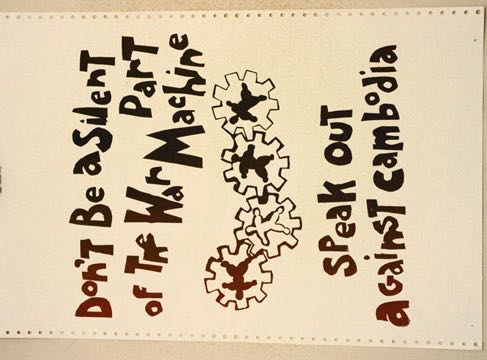
20 August 08
How to Ship a Rare Book
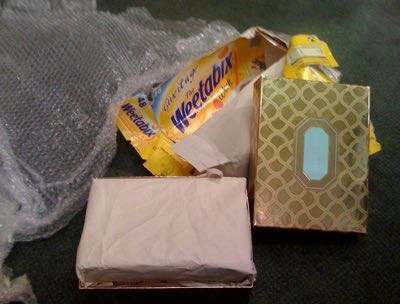
Recycled packing materials (Weetabix box, bubble wrap, Estee Lauder gold-foil covered box, book carefully wrapped and padded in tissue), as received from England this morning in good order. Note that no plain brown paper or twine accompanied this shipment.
Current
Reading
— Netherland by Joseph O’Neill (Pantheon Books,
2008), “a spiky dialect of grammatical shortcuts and jewel-like expressions
I’d never heard before” (47). “ You know what we call
a guy like that in Trinidad? We call him a pawmewan, a poor-me, self-pitying
guy ” (134). Novel of world-weariness and cricket in New York, the
investment-banker narrator’s murdered friend, Chuck Ramkissoon, only begins
to speak in his own voice in the final pages of the book : the passage where
Ramkissoon recounts an experience of terror in the bush in Trinidad is vivid
and compelling.
— The Wonderful and Surprising History of Sweeney Todd. The Life
and Times of an Urban Legend by Robert L. Mack (Continuum, [2007]).
19 August 08
Exercices du style
Larned,
Emily. Lookbook 54 and Lookbook 54 Companion .
Photography by Roxane Zargham.
116 pp., 7 x 10 inches, elastic band & Companion ,
32 pp., 3.5 x 4.5 inches, stapled
New York : Red Charming,
2008. Edition of 100. $30
I mentioned the Oblique Strategies yesterday, the aleatory oracle in
the form of a deck of cards formulated by Brian Eno and Peter Schmidt
(Second edition, 1978), and one of the organizing principles of the Endless
Bookshelf. A useful strategy to remember is « Repetition is
a form of change » — a notion long familiar to magicians
and block printers, &c. The most notable literary expression is probably
in Raymond Queneau, Exercices du style (Paris, 1947).
One interesting and effective visual adaptation is Matt Madden’s
recent 99 Ways to Tell a Story. Exercises in Style (Chamberlain,
2005). Madden plays with minimal narrative elements and a succession
of inventive constraints to evoke possibilities.
Emily Larned is known to readers of the Endless Bookshelf through her
earlier works Thrift Store (2003) and Thrift Store (2005).
She writes, “What is the most reductive form that can yield the
most variety in meaning ? Possibly the white t-shirt. Tight it is
James Dean, huge it is hip hop. It’s not what you wear, it’s
how you wear it.”
Lookbook 54 is bold, whimsical, and deceptive in its
simplicity. Larned and Zargham dispense with all exterior narrative
elements, using only a multi-colored backdrop, a white tee shirt, and
the human form (Larned’s), with occasional recourse to a pair
of torn jeans. The backdrop alternates from vertical to horizontal
and Larned employs captions to suggestive effect : Morning After,
Choreday, Bellevue, Origami. Here, form and function are indivisible. Lookbook
54 is a book that demands to be taken apart for experimentation.
The Endless Bookshelf will be sending this copy out for field trials
and/or a report on actual use.
18 August 08
A Month of Books
A month of books : seeing, talking, proposing, buying, lifting,
shelving, admiring, and even reading. As the Oblique Strategy suggests, « Make
an exhaustive list of everything you might do and do the last thing on
the list » (I will attend to other overdue topics in due course).
So. I am currently reading or have just finished :
— The Hole in the Wall by Arthur Morrison (1902 ;
Folio Society, 1978). Morrison’s first book was Tales of Mean Streets (1894)
and I would bet a tanner or more that Raymond Chandler had read that book in
his youth, long before he sent Philip Marlowe down those mean streets on the
other side of the globe, in Los Angeles.
— The Japanese Corpse by Janwillem van de Wetering
(Soho paperback, 1996, second printing). Re-read. “ ‘ To
die is to travel,’ the commissaris said. ‘ It should be the
most interesting journey of all the journeys a man can make.’ ”
— Works of Art. Selected Short Fiction of James Blish edited
by James A. Mann, with a critical introduction by Gregory Feeley (NESFA Press,
2008). I had always associated Blish with the biological sciences (for example, "Surface
Tension") and with high cultural ideals, all of which is true. This collection
has a few stories not included in the second edition of Blish’s own selection,
the Best Science Fiction Stories of James Blish (Revised Edition) (Faber & Faber,
1973). “How Beautiful with Banners” is a great story (in the NESFA
collection). “We All Die Naked” is one story that earns the 1973
collection a place on my shelf. I noticed something about Blish that I had not
previously considered and am shaping a short essay as a result.
— The Galanty Show. An Autobiography of Montague Summers with
an introduction by Brocard Sewell (Cecil Woolf, [1980], one of 30 specially bound
copies). Interesting compendium of recollections by scholar of witchcraft and
the Gothic. Summers articulates an interesting position on ghosts, and has a
sharp eye for the literature of the nineteenth century (Le Fanu, for example).
One beautiful little passage will serve :
There used to be a local saying : ‘ Where in England can you hear lions roar and the nightingale sing ? ’ The answer was : Clifton. Standing on the slope of the Down one could actually hear the lions roaring in the Zoological Gardens, whilst at the same time the nightingale was singing in the Leigh Woods on the other side of the Avon (19).
Research is like treasure hunting, and to do it well you must be skeptical, curious, discriminating, persistent, and willing to look beneath the surface.
Her blog assembles thoughts on tools and attitudes necessary to perform consistently accurate research : in a word, know your sources and cite them.
I Wish I Could Be There :
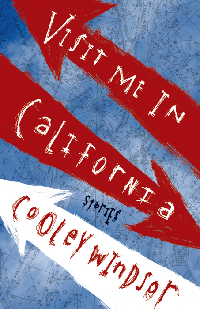
Readings I
— Back to Bologna by Michael Dibdin (2005, Picador
paperback). Tangled, crunchy detective novel of semiotics with nods to Borges,
satires of reality television, academe, and authorship. I left one this on a
plane, alas, and so I cannot quote with accuracy.
— The Tiger in the Smoke by Margery Allingham (1952 ;
Penguin paperback). I wonder if the author was aware of the way in which she
restricted the agency of her female characters.
— The Wasp Factory by Iain Banks (1984 ; Abacus
paperback, 2008). Nasty, wrenching events in a sharp plot, with a surprising
twist.
— Eunuchs and Sacred Boundaries in Islamic Society by
Shaun Marmon (Oxford University Press, 1995).
— Middlesex by Jeffrey Eugenides (2002 ; paperback).
Complex multigenerational narrative in which the narrator explicitly addresses
the question of how events at which one cannot have been present are to be integrated
into the novel. Especially beautiful is the evocation of Smyrna before the incidents
chronicled in, say, in our time by Hem ; and the savage aftermath ;
as well as immigrant life in Michigan.
Readings II — Notes
on Criticism
— Make It New by Ezra Pound (Faber & Faber, 1934) :
Criticism— On Difficulty and other Essays by George Steiner (OUP, 1978)
— by discussion
— by translation
— by exercise in style ("imitation")
— via music, in setting in new composition
— to forerun composition (formulated by the one who produces the demonstration)
— excernment (curator of museum or gallery)
Multiplicity of meaning, 'enclosedness', are the rule rather than the exception. Lexical resistance is the armature of meaning, guarding the poem from the necessary commonalities of prose. 21
a language-act is inexhaustible to interpretation precisely because its context is the world 26
Classes of difficulty :
— contingent (homework)
— modal (no answers to be ‘ looked up ’)
— tactical (political or personal or metrical constraints)
— ontological
What Homer is to poetry in Mallarmé’s model, Plato and Aristotle are to the Heideggerian diagnosis of the ‘ amnesia of true Being ’ in western rationalism. 43
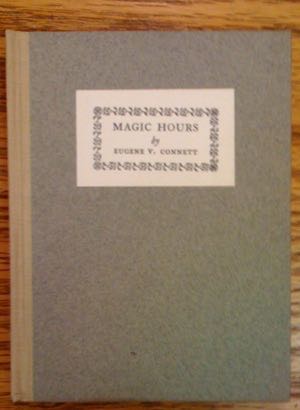
A rare little book.
Readings III — Mostly
Science Fiction
— The Baum Plan for Financial Independence and Other Stories by
John Kessel (Small Beer Press, [2008]). Simply, brilliant stories : perfect,
resonant form ; several are sophisticated critical fictions. I particularly
enjoyed the title story and " The Invisible Empire ".
— Other Worlds, Better Lives. A Howard Waldrop Reader. Selected
Long Fiction 1989-2003 by Howard Waldrop (Old Earth Books, forthcoming
2008). Wow ! The companion to Things Will Never Be the Same .
Great tales, especially " Fin de Cyclé " and " You Could Go
Home Again ".
— What It Is We Do When We Read Science Fiction by Paul Kincaid
(Beccon, 2008). Collection of critical essays.
SURVEY QUESTIONS :
Please answer with number of question you are answering.
Also try to be as concise as possible so data entry will be simple
FIRST NAME ___________
1. A MASKED LIBRARIAN SNEAKS INTO YOUR HOME WITH A TAPE MEASURE. HOW MANY FEET OF BOOKS DOES HE DISCOVER _______ ?
(E.G. HOW MANY SHELVES/STACKS AND HOW LONG)
2. I ORGANIZE MY BOOKS BY _______
(PLEASE DESCRIBE HOW YOU ORDER YOUR BOOKS).
3. I KEEP (YOUR BEST GUESS) ____ % OF MY BOOKS ON SHELVES; ____% IN STACKS OR PILES; ___ % AT MY BEDSIDE. ____ % ON BACK OF TOILET. ____ % OTHER (PLEASE DESCRIBE).
4. EVERYONE HAS THIS BOOK, AND I ALSO HAVE THIS BOOK : __________________.
5. ONE BOOK IN MY COLLECTION EMBARRASSES ME ; IT IS ____________________.
6. A CULTURAL ANTHROPOLOGIST BREAKS INTO YOUR HOME AND DISCRETELY OBSERVES YOUR READING HABITS ; SHE DISCOVERS THAT YOU READ ______ MINUTES A DAY.
7. I READ ____ PAGES BEFORE I GET DISTRACTED, BORED, HUNGRY, OR SLEEPY.
8. YOU ARE GUILTY OF NOT READING — WHAT ARE YOU DOING INSTEAD ? ___________________.
HOW MUCH DAILY TIME DO YOU SPEND DOING THAT GUILTY THING ? _____ MINUTES.
9. WHAT PERCENTAGE OF YOUR BOOKS HAVE YOU READ ? _______ %
10. SOMEONE IS BURNING YOUR BOOKS ! YOU HAVE TIME TO SAVE ONE BOOK. THIS BOOK IS __________________.
DO YOU WANT TO PARTICIPATE IN A WALKING TOUR OF HIDDEN HOME LIBRARIES, AND SHOW YOUR LIBRARY TO PEOPLE YOU DONÍT KNOW (YET), PLEASE CHECK _____YES OR ______NO.
IF YES, PLEASE GIVE CONTACT INFORMATION, ONLY USED TO ORGANIZE WALKING TOURS.
ADDRESS & CROSS STREET :
ELECTRONYM :
PHONE :
From the San Francisco Bay Guardian : “ ‘Maybe they just happen to love books.’ Everyone on the tour will be an ‘active participant,’ he said. To sign up, people will fill out a survey and must agree to include their own home library on the tour „ if it fits the grid of walkable homes that weekend. ”
HOW TO ORGANIZE A PUBLIC LIBRARY
Walking tours Aug. 23 and 30 (also Sept. 20 and 27), noon — 4 p.m. Locations to be announced. For reservations, call 415.978.2710, ext. 136, or go to www.apleafortenderness.com
Forever
Peace : an update
The trial binding in handmade pastepaper covered boards.
Inside :
The book will be on view at the Small Beer Press tables at Readercon tomorrow afternoon and Saturday. See you there.
Recent
reading :
— Mary Barton by Elizabeth Gaskell (Oxford paperback).
— The Pursuit of Pleasure. Drugs and Stimulants in Iranian History,
1500-1900 by Rudi Matthee (Princeton University Press, 2005).
8 July 08
Found Poetry
think o’ soar !
Seen from the train window, Watsessing Avenue, Newark, N.J., this morning 8 July.
— — — —
Lost Poetry
Tom
Disch died in New York City on Friday 4 July 08.
I am glad I took a small speaking part in his life during the last couple
of years — assisting with salvage of material from his house
in Barryville and placement of his archive at Yale, acting as a friendly
intermediary for one or two books — and saw him make some
new connections to the writing world. Whatever circumstantial or metabolic
fluctuation pushed him to that impulse made final by the availability
of a gun, we will never know, but he was despondent all the years I knew
him (had been since Charlie’s death, I guess) — only
the gloom was sometimes leavened with flashes of humor and dark glee.
Go read On Wings of Song (1979) or The Priest. A Gothic
Romance (1994) or The Castle of Perseverance. Job Opportunities
in Contemporary Poetry (2002) or The Dreams Our Stuff
Is Made of. How Science Fiction Conquered the World (1998)
or . . . the list is long.
6 July 08
Forever Peace. To Stop War : a progress report
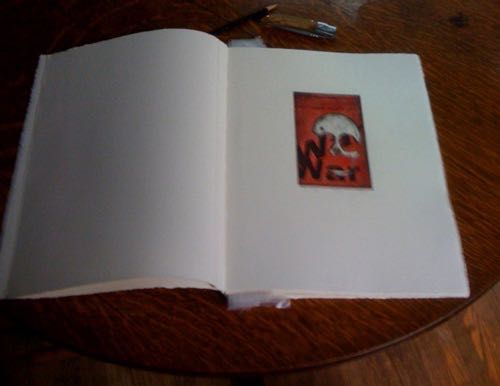
The text of the poem is at the printer, the artist is printing the etchings, and I have solved the binding structure the book opens flat. Next step, the covers. The book will be on display at Readercon at one of the Small Beer Press tables (the Anonymous Other and I managed to sit down and have dinner with Gavin Grant during a recent trip to Massachusetts).
Janwillem van de Wetering
I received word today that Janwillem van de Wetering died on Friday 4 July 08. He was 77, and had written me a farewell letter early in the spring that was remarkable for its clarity and directness in confronting death, but then he had written some years ago :
“ Perhaps he didn't mind if he died, the commissaris thought. He thought death was exciting, a journey — he liked journeys. ”I met Janwillem only a few times, first in Philadelphia a decade ago (after a series of e-mail interviews for a profile in AB Bookman’s Weekly ). Reading his work — which I discovered quite by chance in the old Mysterious Bookshop on 56th street — had a significant impact on my own writing. He was a courageous and provocative thinker ; and his reflections on the limitations of genre or formula are instructive.
Recent
reading :
— Little Brother by Cory Doctorow (Tor, 2008). I really
liked this book and gave away a dozen copies. The narrative voice, the personality
of the seventeen-year-old hacker Marcus, is brilliant.
— Maps. The Uncollected John Sladek edited by David
Langford (2002; Cosmos Books, 2003). Great content in an inferior package, a
print-on-demand hardcover, what Reno Odlin used to call a paperback in drag (glued
pages, doesn’t open flat) : while the material of the dress is an
acceptable blue denim, the seams are crude and some of the rhinestones are crooked.
Just get the paperback.
— Manhattan Nocturne by Colin Harrison (1996; Picador
paperback, 2008). Dark and depraved and tangled. Some of the narrator’s
domestic life strains credulity (until things start to fall apart) but that is
a trifle : the novel ranges from penthouses to slum basements and has a
great, grotesque portrait of a ruthless billionaire newspaper owner.
— The Oxford Book of Modern Science Writing edited
by Richard Dawkins (OUP, 2008). With one or two exceptions, the selections are
limited to scientists who wrote in English; an interesting mix of ideas and deft
expressions of them. The table of contents reveals a colossal gender imbalance.
21 June 08
Bookshelves on an upper floor in the house on the hill :

19 June 08
Little
Brother by Cory Doctorow (Tor, 2008)
I am in the midst of this thought-provoking and fun book and plan to
buy five or six copies to give to high school kids I know. I first heard
about the book from Michael Swanwick and David Hartwell (at the Avram
Davidson Society luncheon). The book has been widely praised and merits
all the attention it will surely get.
14 June 08
Announcing a new book from Temporary Culture :
Forever Peace. To Stop War
Poem by Joe Haldeman
Nine Etchings by Judith Clute
11 x 14 inches, [4] pp. + 9 original etchings (each signed by the artist)Edition of 30 copies printed letterpress, with aquatint etchings printed by the artist from the original plates (two with added color), hand bound in patterned paper over boards. Forthcoming 31 October 2008 in Upper Montclair and London.
Terms of subscription and further details.
A bookcase in Camden Town :
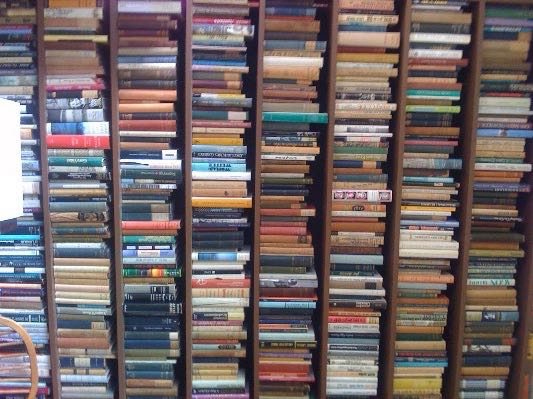
The
John Sladek Society ; or, Other Events in Camden Town :
Announcing the formation, on 5 June 2008, of the John Sladek
Society, to promote interest and awareness in the life and writings
of American-born author John Sladek (1937-2000), whose novels include The
Reproductive System (1968), a book that established
him as one of the great satirists of science fiction. Sladek was also
founding editor of Ronald Reagan. The Magazine of Poetry (2
issues, 1967), where New Wave authors such as Thomas M. Disch, Pamela
Zoline, J. G. Ballard, and others were contributors. Other works
include The Müller-Fokker Effect (1970)
and the Roderick novels. Sladek lived in London
through 1986, when he returned to the U.S. Maps (2002;
Cosmos, 2003) collects materials from all phases of Sladek’s career,
and has a splendid introductory essay by editor David Langford.
In a draft for an obituary of Sladek (published in Locus for
April 2000), Disch wrote :
“Back in January of 1968, when we were living in London, in a squalor worthy of today’s Mozambique but also in the glory of our own self-declared genius, I wrote a poem in memory of John Sladek. He had not died at that point, but I was sure he would in due course, and this way I would have an elegy prepared against the day. It was a Petrarchean sonnet, no less . . . [Sladek] was the kind of laughing fatalist who understood right from the cradle that the grave was there as the punchline of life’s big joke.”Sladek was resident at 221B Camden High Street, London, for several years during the late 1960s, with Zoline and Disch — the address is celebrated in science fiction circles — and the chief aim of the Society is to secure the placement on 221B Camden High Street of a Blue Plaque designating the cultural significance of this address in the literary landscape of London and the world ; and to encourage congenial gatherings where one or more of the directors may be present. As Sladek will only be eligible for designation in 2020 under the current nominating criteria of English Heritage, the John Sladek Society has a timetable of palaeontological increments, but its activities will be continuous, and the society will be ready to accelerate.
John Sladek was the high priest of something else , the clown in the choir, the valet who takes your keys to the Rolls and brings you an ice cream truck. He was a wonderfully funny and engaging writer, a satirist of the first rank, and he deserves to be remembered.— James Sallis
The founding directors of the Society are Thomas M. Disch, Honorary Chairman, John Clute, Judith Clute, and Henry Wessells (to whom correspondence may be directed, to : wessells [at] aol [dot] com ). Further details, including the John Sladek Museum and a picture of the London landmark (now handsomely painted burgundy), will be presented in a timely fashion.
A bookcase in an undisclosed location :

21 May 08
Recent
reading :
— Earth House Hold by Gary Snyder (New Directions,
[1969]). Interesting miscellany of journal entries, essays, and poetic fragments,
deeply engaged with an ecological awareness and a pleasure in observing “the
world-creating dance, ‘expanding form’ ” (the essay on
Poetry and the Primitive. Notes on Poetry as an Ecological Survival Technique).
— Paris. A Poem by Hope Mirrlees (Hogarth Press, 1919
[but: 1920]). Modernist poem, "highly allusive and typographically original,
it has claims to be the missing link between French avant-garde poetry and Eliot’s The
Waste Land " (Julia Briggs, in the DNB).
— Steampunk Ann & Jeff Vandermeer, editors (Tachyon,
2008). Anthology of short fiction in the steampunk mode, including classic stories
such as “Lord Kelvin’s Machine” (1985) by James P. Blaylock,
and more recent pieces. The essay on origins briefly notes Moorcock’s The
Warlord of the Air (1971) as proto-steampunk, and then examines nineteenth
century dime novels. I think that one must add Burroughs’ The Wild
Boys , also 1971, as proto-steampunk, for its nostalgic poetics of
meals and names (the litany of railroad stations, extinct animals), the retrospective
fashion, and general attitude. I don’t have that book at hand or I would
cite a couple of passages.
— Peregrine : Primus by Avram Davidson (Walker, 1971).
The best short summary of the Odyssey (pp. 45-6) anywhere ; and many other
whimsies and pleasures [Re-reading].
19 May 08
The
affirmation in the negation ; or, The poem upon the stairs
— A curious (and unstaged) picture of a small group of books on my shelves.
The country you have never seen
Tales my father never told
Almost no memory
Why I don’t write like Franz Kafka
Things will never be the same
On the shelf below are to be found : A glimpse of nothingness , The empty mirror , and The power of nothingness .
3 May 08
Recent
reading :
In the small hours of this morning I finished a review of the new collection
of critical writings by Joanna Russ, The Country You Have Never Seen ,
which I first picked up a couple of
months ago. Since my knowledge of
Russ was limited to her novel The Female Man and a few
short stories I read some of her earlier work : The Zanzibar
Cat (1983) (short stories, two of which are critical fictions), How
to Suppress Women’s Writing (1983), and To Write
Like a Woman. Essays in Feminism and Science Fiction (1995). All
highly recommended. The review will appear in a forthcoming issue of The
New York Review of Science Fiction .
I have also been reading a curious new book by Gregory Gibson, Hubert’s
Freaks. The Rare-Book Dealer, the Times Square Talker, and the Lost Photos
of Diane Arbus (Harcourt, 2008). the adventures of Bob Langmuir : "Bob’s
archive was the same kind of evidence Harry Smith’s recordings
[The Anthology of American Folk Music (1952)] had been.
Just as Greil Marcus had presented [Bob] Dylan’s work in the context
of the "mystical body of the Republic" conjured up by Smith’s recordings,
so the old, weird America of Hubert’s, and Charlie, and the Bostocks
would be the context for the presentation of the Arbus photos."
The River Runs through It by Norman Maclean, with wood engravings
by Barry Moser (Pennyroyal Press, 1989). A beautiful book and an engaging
story of two brothers and their father in rural Montana in the late 1930s.
The
Avram Davidson Society Luncheon
Each year in early May, the Avram
Davidson Society holds its annual luncheon to celebrate the life
and writings of the American fantasist Avram Davidson. This year, for
the tenth anniverary of its founding, the society was obliged to find
a new venue, as the long-time favorite, Zen Palate on Union Square East,
closed last autumn. Attendance is small but convivial, the conversation
is varied, and the new esoteric vegetarian restaurant of choice, Hangawi,
has a wide selection of appetizers and starters to satisfy the secondary
aim of the society : to enjoy the luncheon. There were in attendance
several founding directors of the society, editors of Davidson, and a
new face.
27 April 08
The
Child in Time by Ian McEwan
I am re-reading The Child in Time by Ian McEwan (Jonathan
Cape, 1987), a taut and devastating book that is my favorite of his works.
Part of the enduring charm is in the complex layering of memory and event,
the narrator’s uncertainty about key incidents, and the utter Englishness
of the novel.
After the most suggestive passage about parked bicycles outside of Avram
Davidson’s " Or All the Seas with Oysters " ,
Stephen looks through the window of an English country pub, The Bell ,
and sees his parents before he was born (pp. 57-60). That the vision
is experienced but never quite explained (see pp. 91,
116-20, & 175-6) is the primary reason the scene remains fresh and
memorable for me.
It strikes me that Stephen’s vision approaches a perfect response to William S. Wilson’s challenge * to a writer :
You had given me, not the motifs for the stories, but the impulse, the energy, as you said, to overcome the intimidations, and I had written as you had suggested, " The story I would not want my mother and father to read," " The story I would not want Owen to read," " The story I would not want my daughter to read," . . . I want you to do something for me that may do something for you, and that is to accept from me the sort of assignment that I used to accept from you. Now that you have read my letter, write the story that you would want me to read.
* " Conveyance : The Story I Would Not Want Bill Wilson to Read " in Why I Don’t Write Like Franz Kafka (Ecco Press, 1977).
On re-reading The Fellowship of the Ring some years back, I was surprised to find how economical Tolkien’s description of Merry and Pippin being trapped by the old willow tree actually is. Similarly, I was interested to note that Charles Darke’s descent into madness occupies rather fewer pages of The Child in Time than its shadow or resonances throughout the novel (the pathology of turning out his pockets for Stephen is at its heart) ; and that only in the strictly descriptive "five-hundred-acre wood" is there direct intimation of Christopher Robin’s Hundred Acre Wood . . .
A Field Guide to the North American Family. Concerning chiefly the Hungates and Harrisons ; with Accounts of their habits, nesting, dispersion, etc., and full description of the plumage of both adult and young, within a taxonomic survey of several aspects of familial life by Garth Risk Hallberg (Mark Batty Publisher, 2007)
I found this ironic, postmodern illustrated book when I was in Bluestockings on Allen Street early in April and read it with increasing interest. The Field Guide is a series of sixty-three vignettes concerning two families on Long Island, arranged in alphabetical sequence by "subject headings", with suggested cross-references to further shuffle the traditional linear narrative. The nature of reading is to create order and coherence, despite the odds , so as one reads through the Field Guide , the fragmented scenes cumulate into a genuine tragedy of wasted potential and loss : the ironic stance vanishes. A pleasure to read and look through.

Material
One house, three cars, four sets of clothes, gratuitous amounts of shoes, daily medications, weekly groceries, glossy monthlies, a year’s supply of firewood for the wood-burning stove, a garage worth of tennis rackets and basketballs, a lifetime of cigarettes. Honey can I, Daddy can’t I, Dad why can’t I, won’t you, will you ? Please would you write a check, please can I have some cash, please could we put your name down for a small donation ? Of course Frank would. He can. He could. For cellphones and Palm Pilots and personal computers, he’d shell out. For cornerstones and uniforms and meals on wheels for the elderly. These things cost money, but then that’s why he worked. In the end, it was easier to say yes.
The
book apparently grew out of a website but
the images there do not correspond to the commissioned photographs
in the Field Guide .
The Ship That Sailed to Mars by William Timlin (1923)
It is always a joy to show a friend a classic book that one loves — and doubly so when the enthusiasm is shared immediately ! Ellen Kushner, author of The Privilege of the Sword (2006), etc., came by the booth at the New York Book Fair and we had a delightful time with Timlin’s masterpiece, The Ship That Sailed to Mars , and we could leaf through the artist’s sketchbook, too !
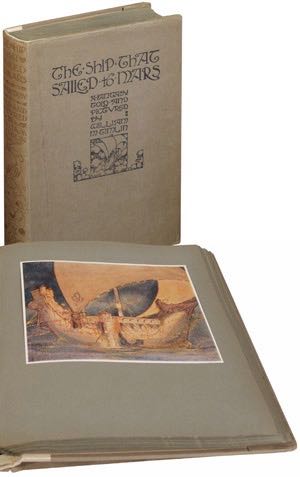
21 April 08
Life-changing
books : recommendations from 17 leading scientists
Interesting group of articles in the New Scientist . But
don't just look at the list, each of the essays unfolds into a glimpse
of other books and ideas that changed the scientists' lives : Jane
Goodall, for example, mentions The Story of Doctor Dolittle and Tarzan
of the Apes as sparking her "burning desire to understand
what animals were trying to tell us". ( Link to
the articles )
1. Farthest North — Steve Jones, geneticist
2. The Art of the Soluble — V. S. Ramachandran, neuroscientist
3. Animal Liberation — Jane Goodall, primatologist
4. The Foundation trilogy — Michio Kaku, theoretical
physicist
5. Alice in Wonderland — Alison Gopnik, developmental
psychologist
6. One, Two, Three . . . Infinity — Sean
Carroll, theoretical physicist
7. The Idea of a Social Science — Harry Collins,
sociologist of science
8. Handbook of Mathematical Functions — Peter Atkins,
chemist
9. The Mind of a Mnemonist — Oliver Sacks, neurologist
10. A Mathematician's Apology — Marcus du Sautoy,
mathematician
11. The Leopard — Susan Greenfield, neurophysiologist
12. Darwin and the Emergence of Evolutionary Theories of Mind and
Behavior — Frans de Waal, psychologist and ethologist
13. Catch-22 / The First Three Minutes — Lawrence
Krauss, physicist
14. William James, Writings 1878 - 1910 — Daniel
Everett, linguist
15. Do Androids Dream of Electric Sheep ? — Chris
Frith, neuroscientist
16. The Naked Ape — Elaine Morgan, author of The
Aquatic Ape Hypothesis
17. King Solomon's Ring — Marion Stamp Dawkins,
zoologist
6 March 08
Books at work (part of an ongoing series) :
From [JC] : There two bookshelves, quite tall, in a corner ; I send the right side first, which has a lot of the research for [my] books going back to the beginning plus some newer things — you might be able to read the titles.
Here's the right-hand side, consisting mostly of odd multiple sets (Osbert Sitwell's memoirs, Victoria's letters, a Mathers and Mardrus Arabian Nights), some books important to me as a child, and a shelf of lit-crit (mostly Bloom.) [JC]
24 February 08
“ I
disdain categories. ”
said [RH] in response to a request for information about his library,
and then proceeded to delineate categories which he felt his wife would
assign to the books in their house :
— Reference books (twentieth century art)
— His books
— Science fiction & thrillers
— My books
(as reported by [RH])
Recent reading & new arrivals :
— The Country You Have Never Seen.
Essays and Reviews by
Joanna Russ (Liverpool University Press, [2007]). Collection of reviews dating
from December 1966 to 1981, essays (chiefly 1969 to 1981, and one from 1989) ;
and letters to literary journals (1970 to 1995). A few author's notes seem to
indicate subsequent attention to the pieces. A fierce intellect at work, directly
confronting topics that other reviewers and critics skirt or fail to notice.
Russ’ readings of The Dispossessed and The Left Hand of Darkness by
Ursula K. Le Guin are fascinating. Original publication credits are clearly identified
but the index is profoundly flawed and only selectively notes titles and authors
from the first section of reviews (thus under Le Guin there is no reference to The
Left Hand of Darkness as it appears in “ The Image of Women in
Science
Fiction ”). The book has no front matter, just a terse potted biographical
note on the back cover, and is as close to anonymous as it could be possible
for a
book by such a notable author : except for the fireworks of the voice. I
shall need to find a copy of To Write Like a Woman. Essays in Feminism and
Science Fiction (1995) in order to put this book into context.
— Infinite Riches. The Adventures of a Rare Book Dealer by
David Magee (Eriksson, [1973]). Far and away the best memoir by an antiquarian
bookseller, fun, self-deprecating, and just the right length. And boy !
did he have some great books pass across his desk. (I re-read this last week.)
— Bland Beginning. A Detective Story by Julian Symons
(Gollancz, 1949). Excellent novel of 1920s middle-class British life, murder,
and bibliography ; the bibliographical puzzle is adapted from John Carter & Graham
Pollard's exposé of the forgeries of Thomas Wise, An Enquiry into
the Nature of Certain Nineteenth Century Pamphlets .
— A Guide to Irish Fiction 1650-1900 by Rolf Loeber
and Magda Loeber (Dublin : Four Courts Press, [2006]).
12 February 08
Categories & methods
of imposing order :
the following lists of criteria for shelving and/or areas of collecting
emerged during a recent conversation.
— tall
to small
— fiction to science
— art to science
— also embroidery and dye
— then there’s Hitler, the secret room in which to hide like
Anne Frank if Hitler seizes power (culls & stacks of unsorted books)
[RLB]
— plant
books
— field guides
— old books with pictures
— art
— poetry
— books from HW
[AW]
— natural
history
— botany
— cookbooks : food & sociology of food
— literature
— art
— fiction
[JB]
— history
— politics
— everything else
— current / books of past or future
[SS]
who also raised the question of the earthquake shelf or box : what
to take from the burning building
— stories
and fairy tales
— everything else
[MS]
— literature
of the fantastic
— books by (or from) friends
— reference books & books about books
— OTW (off the wall) : odd, indispensable, or just weird
[HW]
Recent
reading :
— The Brief Wondrous Life of Oscar Wao by Junot Diaz
(Riverhead, 2007).
This creaking and constantly evolving blog of the endless bookshelf : I expect that some entries will be brief, others will take the form of more elaborate essays, and eventually I will become adept at incorporating photos or comments and interactivity. Right now you’ll have to send links to me, dear readers. [HW]
electronym
: wessells at aol dot com
Copyright © 2008 Henry Wessells and individual contributors.
Produced by Temporary Culture, P.O.B. 43072, Upper Montclair, NJ 07043
USA.
